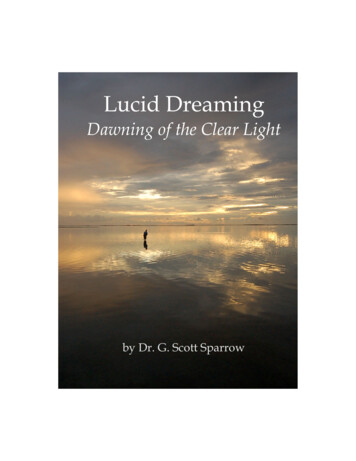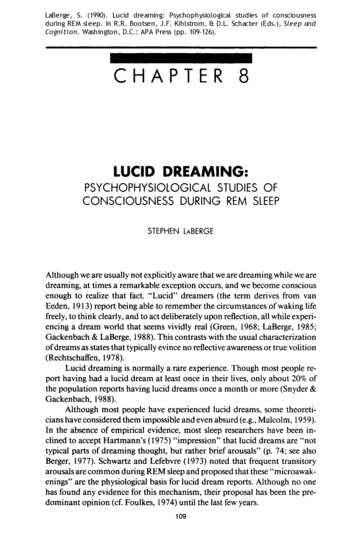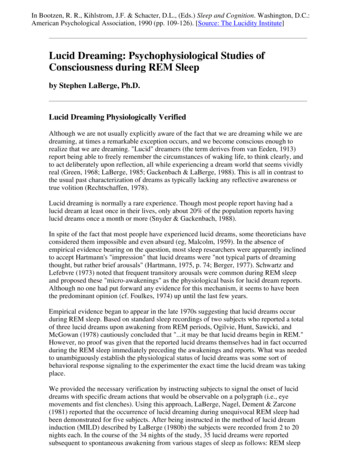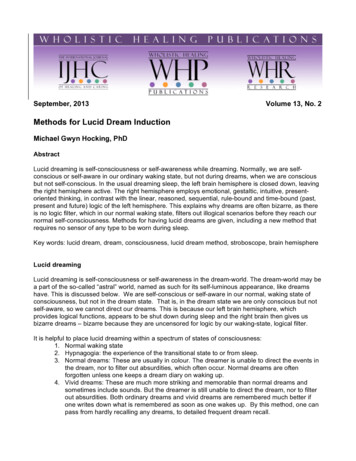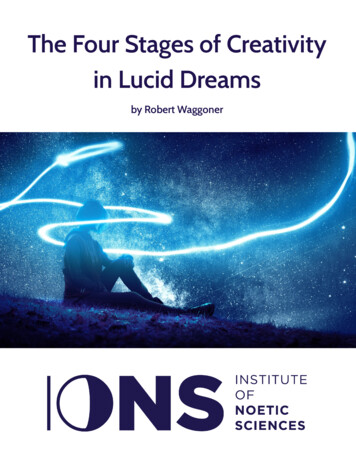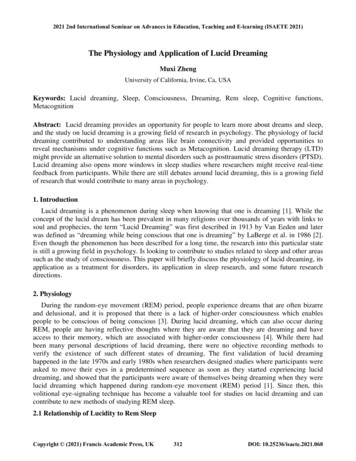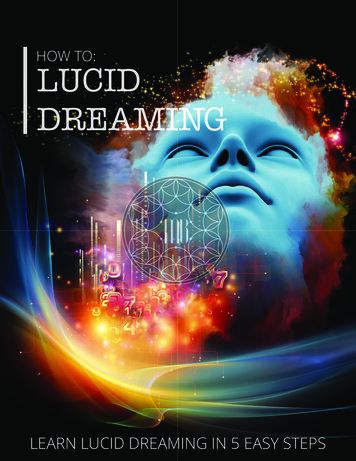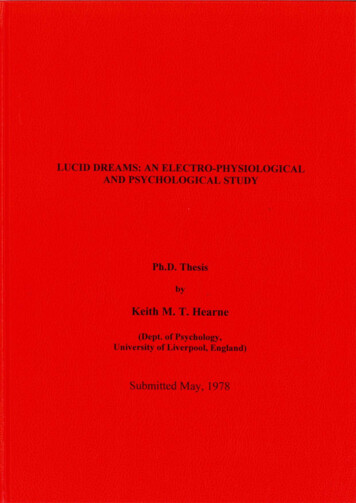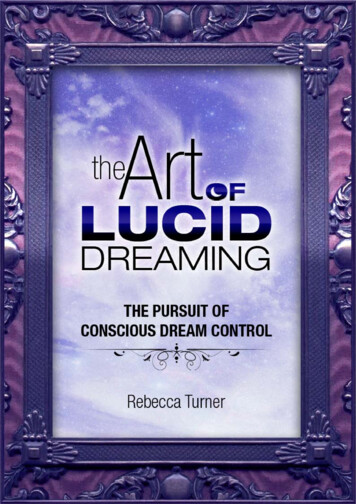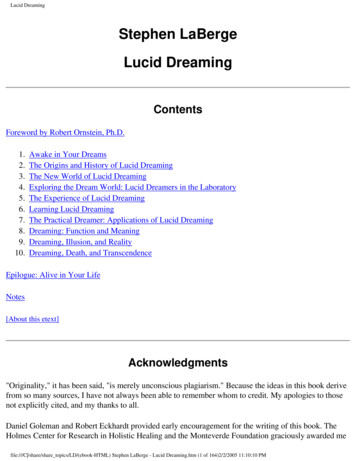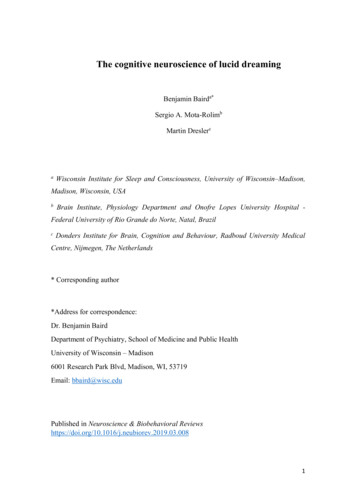
Transcription
The cognitive neuroscience of lucid dreamingBenjamin Bairda*Sergio A. Mota-RolimbMartin DreslercaWisconsin Institute for Sleep and Consciousness, University of Wisconsin–Madison,Madison, Wisconsin, USAbBrain Institute, Physiology Department and Onofre Lopes University Hospital -Federal University of Rio Grande do Norte, Natal, BrazilcDonders Institute for Brain, Cognition and Behaviour, Radboud University MedicalCentre, Nijmegen, The Netherlands* Corresponding author*Address for correspondence:Dr. Benjamin BairdDepartment of Psychiatry, School of Medicine and Public HealthUniversity of Wisconsin – Madison6001 Research Park Blvd, Madison, WI, 53719Email: bbaird@wisc.eduPublished in Neuroscience & Biobehavioral .0081
AbstractLucid dreaming refers to the phenomenon of becoming aware of the fact that one isdreaming during ongoing sleep. Despite having been physiologically validated fordecades, the neurobiology of lucid dreaming is still incompletely characterized. Here g,includingelectroencephalographic, neuroimaging, brain lesion, pharmacological and brainstimulation studies. Electroencephalographic studies of lucid dreaming are mostlyunderpowered and show mixed results. Neuroimaging data is scant but preliminaryresults suggest that prefrontal and parietal regions are involved in lucid dreaming. Afocus of research is also to develop methods to induce lucid dreams. Combining trainingin mental set with cholinergic stimulation has shown promising results, while it remainsunclear whether electrical brain stimulation could be used to induce lucid dreams.Finally, we discuss strategies to measure lucid dreaming, including best-practiceprocedures for the sleep laboratory. Lucid dreaming has clinical and scientificapplications, and shows emerging potential as a methodology in the cognitiveneuroscience of consciousness. Further research with larger sample sizes and refinedmethodology is needed.Keywords: lucid dreaming; consciousness; meta-awareness; dreaming; REM sleep2
1. IntroductionBecoming aware that one is dreaming while dreaming, what is today referred to aslucid dreaming, has been known about since antiquity. In Western literature, it mayhave first been mentioned by Aristotle in the fourth century BCE in the treatise Ondreams of his Parva Naturali, in which he states: “often when one is asleep, there issomething in consciousness which declares that what then presents itself is but a dream”(Aristotle, 1941, p. 624). Likewise, in Eastern cultures, particularly of the south Asiansubcontinent, reports of individuals engaging in practices to cultivate awareness ofdream and sleep states date back millennia (LaBerge, 2003; Norbu and Katz, 1992;Wallace and Hodel, 2012). These include meditative practices specifically designed to“apprehend the dream state” (Padmasambhava, 1998, p. 156).Although numerous references to lucid dreaming can be found throughout worldliterature (see LaBerge, 1988a for an overview), the modern nomenclature of luciddream was not introduced until 1913 by the Dutch psychiatrist Frederik Van Eeden. In adetailed and engaging account of his personal experiences with dreams, Van Eeden(1913) referred to lucid dreams as dreams in which “.the reintegration of the psychicfunctions is so complete that the sleeper remembers day-life and his own condition,reaches a state of perfect awareness, and is able to direct his attention, and to attemptdifferent acts of free volition” (pp. 149-150). Research over the last four decades haslargely confirmed Van Eeden’s accounts: as we review below, evidence suggests thatduring lucid dreams individuals can be physiologically asleep while at the same timeaware that they are dreaming, able to intentionally perform diverse actions, and in somecases remember their waking life (Dresler et al., 2011; LaBerge, 1985, 1990; LaBerge,2015; LaBerge, Nagel, Dement and Zarcone, 1981c; Windt, 2015).Despite the fact that such personal accounts of lucid dreams have been described forcenturies, the topic faced skepticism from some scientists and philosophers (e.g.,Malcolm, 1959), in part due to the lack of objective evidence for the phenomenon. Thisbegan to change in the late 1970s and early 1980s, however, with the first validation oflucid dreaming as an objectively verifiable phenomenon occurring during rapid eyemovement (REM) sleep. Building on prior research that showed that shifts in thedirection of gaze within a dream can be accompanied by corresponding movements ofthe sleeper’s eyes (Dement and Wolpert, 1958), lucid dreamers were asked to move3
their eyes in a distinct pre-agreed upon sequence (full-scale up-down or left-rightmovements) as soon as they became lucid (Hearne, 1978; LaBerge et al., 1981c).Through this technique, which has since become the gold standard, reports of luciddreams could be objectively verified by the presence of distinct volitional (EOG)duringpolysomnography-verified sleep (Figure 1). The most common version of the eyesignaling technique asks participants to signal when they realize they are dreaming byrapidly looking all the way to the left then all the way to the right two timesconsecutively then back to center in the dream without pausing (referred to as left-rightleft-right eye signals, abbreviated as LRLR). As can be seen in Figure 1, the LRLRsignal is readily discernable in the horizontal EOG, which exhibits a distinctive shapecontaining four consecutive full-scale eye movements that have larger amplitudecompared to typical REMs. As we describe in detail below, lucid dreams can bevalidated by this method through the convergence between reports obtained afterawakening of becoming lucid and making the eye movement signals during the dream,accompanied by the objective eye movement signals recorded in the EOG withconcurrent polysomonographic evidence of REM sleep.The eye signaling technique also offers a way of objectively contrasting lucid REMsleep to baseline non-lucid REM sleep, providing a method to investigate the changes inbrain activity associated with lucid dreaming. Furthermore, lucid dreamers can not onlysignal to indicate that they are aware that they are dreaming, but they can also make theeye movement signals to time-stamp the start and end of experimental tasks performedduring lucid dreams (LaBerge, 1990). By providing objective temporal markers, thistechnique has opened up a new method for studying the psychophysiology of REMsleep, allowing, for example, investigations into the neural correlates of dreamedbehaviors (e.g., Dresler et al., 2011; Erlacher, Schredl and LaBerge, 2003; LaBerge,1990; Oudiette et al., 2018). Lucid dreaming thus provides a way to establish precisepsychophysiological correlations between the contents of consciousness during sleepand physiological measures, as well as enables experimental control over the content ofdreams, and therefore provides a potentially highly useful experimental methodology.While neuroscientific studies on lucid dreaming have been performed since the late1970s, the topic has received increasing attention in recent years due to its relevance tothe emerging neuroscience of consciousness. In this article, we review the existing4
literature on the neuroscience of lucid dreaming, including , we review recent studies that illustrate how lucid dreaming can be used asa methodology in the cognitive neuroscience of consciousness. Finally, we presentstrategies to measure lucid dreaming both physiologically and with questionnaires, anddiscuss procedures to investigate lucid dreaming in the sleep laboratory.5
2. Electrophysiology of lucid dreamingAs noted in the introduction, the first physiological studies of lucid dreaming beganin the late 1970s and early 1980s. These pioneer works established that lucid dreamsoccur in REM sleep, characterized by all of the EEG features of REM sleep accordingto the Rechtschaffen and Kales (1968) sleep scoring criteria (Hearne, 1978; LaBerge etal., 1981c). LaBerge (1980b) also observed that lucid dreams are associated withincreased physiological activation, as measured by increased phasic activity (e.g.,increased REM density). Autonomic nervous system arousal (e.g., heart rate, respirationrate, and skin potential) were also found to be elevated during lucid REM sleepcompared to non-lucid REM sleep (LaBerge, Levitan and Dement, 1986). Additionally,lucid dreams were found to occur in REM sleep periods later in the night (LaBerge etal., 1986). These findings suggest that lucid dreaming is associated with increasedcortical activation (LaBerge, Nagel, Taylor, Dement and Zarcone, 1981a), whichreaches its peak during phasic REM sleep. In addition to physiological markers ofphasic activity, lucid REM sleep was found to be associated with h-reflex suppression(Brylowski, Levitan and LaBerge, 1989), a spinal reflex that is reliably suppressedduring REM sleep (Hodes and Dement, 1964). Together these results indicate that luciddreams occur in activated periods of REM sleep, as opposed to, for example, a state thatis intermediate between waking and REM sleep.These findings also raise the further question of whether lucid REM sleep isassociated with localized activation of specific brain regions or changes in specificfrequencies of neural oscillations compared to non-lucid REM sleep. In this section, wewill review EEG studies that have attempted to address this question. As will bediscussed below, while these studies represent important first steps toward measuringthe electrophysiological changes associated with lucid dreaming, all of them haveinterpretive issues and most suffer from low statistical power. As a result, there isconsiderable discrepancy among findings. Below we group and discuss results based onthe regional EEG band power changes reported to be associated with lucid REM sleepdreaming.2.1 EEG studies of lucid REM sleep dreaming6
2.1.1 Central and posterior alphaOgilvie and colleagues conducted some of the first studies to examine EEG spectralchanges during lucid REM sleep. In an early case study, Ogilvie, Hunt, Sawicki andMcGowan (1978) compared two lucid REM sleep epochs to six non-lucid REM sleepepochs and found an increase in the percentage of alpha band (8-12 Hz) power in asingle central EEG channel. A follow-up study examined a larger group of tenparticipants for two nights in the sleep laboratory (Ogilvie, Hunt, Tyson, Lucescu andJeakins, 1982). Participants were awakened during the two periods of highest alphapower and two periods of lowest alpha power from a central EEG electrode duringREM sleep, after which they were asked several questions about their lucidity, “prelucidity” (i.e., thoughts pertaining to dreaming without becoming lucid), and degree ofdream control. Unfortunately, statistics for the number of lucid dreams reported byparticipants were not documented in this study, nor whether there was a significantdifference between conditions in the number of lucid dreams. Instead, a compositemeasure was constructed by collapsing across pre-lucidity, lucidity and control, whichwas significantly elevated in the high alpha trials. Therefore, the number (if any) oflucid dreams that were captured by this procedure is unknown (see LaBerge (1988b) forfurther discussion).Subsequent research has not supported the hypothesis that lucid REM sleep isassociated with increased alpha activity. For example, in a follow-up study Tyson,Ogilvie and Hunt (1984) found that only pre-lucid but not lucid dreams significantlydiffered in alpha activity compared to non-lucid REM sleep. In another study of eightfrequent lucid dreamers using a similar experimental design, Ogilvie, Hunt, Kushnirukand Newman (1983) observed no difference in the number of lucid dreams followingawakenings from periods of high or low alpha activity. Furthermore, in a replicationattempt of the original case report that observed an increase in alpha during lucid REMsleep (Ogilvie et al., 1978), LaBerge and colleagues found no significant differences inalpha power at the same central channel (C3) from a single subject (LaBerge, 1988b).Finally, a later follow-up case study analyzed EEG spectral power in five lucid REMsleep epochs compared to non-lucid REM sleep periods, and observed no differences inalpha power (Ogilvie, Vieira and Small, 1991). Together this evidence does not supporta reliable association between alpha power and lucid dreaming. However, the limitedspatial coverage of EEG montages in these studies (in several cases consisting of only7
one EEG channel) makes it unclear to what extent these results can be generalized toother brain areas.2.1.2 Parietal betaHolzinger, LaBerge and Levitan (2006) examined EEG spectral changes duringlucid REM sleep in a group of eleven participants who reported prior experience withlucid dreaming. Six out of the eleven participants succeeded in becoming lucid in thesleep laboratory, and some during multiple REM periods, for a total of 16 signalverified lucid dreams. The authors found increased power in the low beta frequencyrange (13-19 Hz) in parietal electrodes for lucid compared to non-lucid REM sleep. Thisstudy has the advantage of analyzing a larger number of lucid REM sleep periods.However, a limitation is that EEG signals were only evaluated at four electrodes (F3,F4, P3, P4). Consequently, localized changes in EEG spectra may have been missed bythe low spatial resolution. Furthermore, due to technical limitations, the online low-passfilter for the EEG recordings in this study was set at 35 Hz, and therefore changes inhigher-frequency activity were unable to be evaluated.The potential functional significance of increased low beta band power in parietalareas to lucid dreaming is not understood. Holzinger et al. (2006) speculated that theincreased beta power in the parietal EEG could reflect the understanding of the meaningof the words “This is a dream.” As discussed below, recent neuroimaging studies havelinked parietal regions to several other cognitive functions associated with luciddreaming, including self-reflection (Kjaer, Nowak and Lou, 2002; Lou et al., 2004),episodic memory (Berryhill, Phuong, Picasso, Cabeza and Olson, 2007; Wagner,Shannon, Kahn and Buckner, 2005) and agency (Cavanna and Trimble, 2006),suggesting several other possible interpretations of the results. Neural oscillations in thisfrequency range were originally thought to reflect sensorimotor behavior; however,evidence now suggests that oscillations in this range could play a role in cognitiveprocessing as well as facilitate large-scale neural integration (e.g., Donner and Siegel,2011; Engel and Fries, 2010). If these results can be replicated in future studies, onehypothesis is that the increased oscillatory activity in the beta band could reflect amechanism of integration between parietal regions and other areas, which, in some waystill to be understood, helps facilitate lucid dreaming. However, it is also possible thatdifferences in sensorimotor behavior between lucid and non-lucid REM sleep could8
boost brain rhythms that overlap with this frequency range (Koshino and Niedermeyer,1975; Pfurtscheller, Stancak and Neuper, 1996; Vanni, Portin, Virsu and Hari, 1999).Additional research is needed to clarify these findings.2.1.3 Frontolateral gammaMota-Rolim et al. (2008) and Voss, Holzmann, Tuin and Hobson (2009) reportedincreased gamma band (40 Hz) power in frontolateral scalp electrodes during lucidcompared to non-lucid REM sleep in three participants each. However, besides anunsuccessful replication in patients with narcolepsy (Dodet et al., 2014), interpretationof these results are restricted by several experimental limitations, including the smallsample size (LaBerge, 2010). Importantly, caution is warranted in interpreting thesefindings given that, as briefly discussed by Voss et al. (2009), scalp measurement ofcortical gamma, particularly when selectively localized in the frontal and periorbitalregions, may be confounded with mircrosaccades. Ocular myogenic artifacts, whichoccur during both saccades and microsaccades and are distinct from the artifactsassociated with corneo-retinal dipole offsets, may confound scalp measurement ofgamma activity. One type of such artifacts is referred to as the saccadic spike potential(SP), which occurs due to contraction of the ocular muscles during both saccades andmicrosaccades (Yuval-Greenberg and Deouell, 2009; Yuval-Greenberg, Tomer, Keren,Nelken and Deouell, 2008). The influence of the SP artifact on gamma power wasoverlooked for a number of years; however, the need to account for this artifact on scalpmeasurement of induced gamma activity has now been thoroughly documented (e.g.,Hipp and Siegel, 2013; Keren, Yuval-Greenberg and Deouell, 2010).Voss et al. (2009) corrected for eye movement artifacts using regression of the EOGsignal (Gratton, Coles and Donchin, 1983) and by computing current source densities(CSD) in addition to scalp potentials. However, regression-based correction proceduresare insufficient to remove the SP artifact, and while the CSD derivation attenuates theSP artifact at posterior channels, it is not sufficient to remove it at anterior scalplocations (Keren et al., 2010; Yuval-Greenberg and Deouell, 2009). As Keren et al.(2010) state: “In conclusion, SCD [CSD] seems to be effective in attenuating the SPeffect at posterior sites. However at sites anterior to Cz and closer to the orbits efficacygradually decreases, preserving the temporal and spectral signature of the SP and itsamplitude relative to baseline.” (p. 2258). The influence of the SP artifact on gamma9
band power in the comparison of lucid to non-lucid REM sleep is particularly relevantgiven that, as noted above, lucid REM sleep has been associated with increased phasicactivation and higher eye movement density (e.g., LaBerge, 1990).It is important to note that the need to account for the SP artifact does not preclude apotential association between increased frontal gamma power and lucid REM sleep.Indeed, given the link between gamma band power, local field potentials (LFPs) and theblood-oxygen-level dependent (BOLD) signal (Lachaux et al., 2007; Nir et al., 2007), ifthe transition from non-lucid to lucid REM sleep involves activation or recruitment ofadditional frontal brain regions (a plausible hypothesis, also in light of the findings ofDresler et al. (2012); see Neuroimaging of lucid dreaming below), regional increases ingamma power might be predicted. However, the spatial topography and frequencylocalization of any such effects are likely to be strongly influenced by the correction andremoval of the SP artifact.With the aforementioned considerations in mind, more research is needed to clarifywhether the increase in frontolateral gamma power during lucid REM sleep observed byMota-Rolim et al. (2008) and Voss et al. (2009) reflects ocular myogenic or neuralactivity. Furthermore, future studies evaluating the relationship between lucid REMsleep and gamma activity from sensor-level EEG, particularly at anterior electrodes,need to control for the SP artifact in order for the results to be interpretable. Severalmethods have been shown to be suitable for removal this artifact, including directidentification and removal of contaminated data by rejecting overlapping windows oftime-frequency transformed data or data correction using independent componentanalysis (Hipp and Siegel, 2013). A study that evaluates the effect of direct removaland/or correction of the SP artifact on gamma power during lucid contrasted withbaseline REM sleep would be an important addition to the literature. In summary,studies that rigorously control for myogenic artifacts, and in particular the SP artifact,are needed before conclusions can be drawn regarding the relationship between lucidREM sleep and frontal gamma activity.2.1.4 Fronto-central deltaDodet, Chavez, Leu-Semenescu, Golmard and Arnulf (2014) evaluated changes inEEG band power during lucid REM sleep in a group of narcoleptic patients. Given that10
narcoleptic patients often report a high rate of lucid dreams (Rak, Beitinger, Steiger,Schredl and Dresler, 2015), they are a potentially useful population for cognitiveneuroscience studies of lucid dreaming. In the experiment, while both control andnarcoleptic patients reported achieving lucidity and performing the LRLR signalsduring overnight and afternoon nap recordings, only the eye signals of the patientsduring the nap recordings could be unambiguously identified. This is likely at leastpartially attributable to the specific instructions used for making the eye movementsignal (see Section 9 below for discussion of this issue). Despite this, the studysucceeded in recording 14 signal-verified lucid dreams during naps from sevennarcoleptic patients. The main finding was that EEG power was reduced in the deltaband during lucid REM sleep at frontal and central electrodes. The study also reportedthat the coherence between several electrodes was reduced in lucid compared to nonlucid REM sleep in delta, theta, beta and gamma bands, but these differences aredifficult to interpret since no statistics were reported for this analysis and no correctionsfor multiple comparisons were made.A limitation of the Dodet et al. (2014) study is that EEG signals were only evaluatedat six electrodes, and only in frontal and central scalp regions (Fp1, Fp2, F7, F8, C3,C4). Parietal electrodes were not included in the EEG montage, and occipital channelsreportedly could not be evaluated due to noise. Thus, it is possible that local changes inEEG spectra in posterior regions, such as parietal or occipital areas, were missed due tothe limited electrode montage.The finding of lower delta activity during lucid REM sleep is in line with previousobservations that lucid dreams tend to occur during periods of increased corticalactivation (LaBerge, 1990). Specifically, slow waves, reflected by delta ( 0.5-4 Hz)power in the EEG, are associated with neuronal down states (“off” periods) in whichneurons are hyperpolarized (Steriade, Timofeev and Grenier, 2001). Decreased deltapower (EEG activation) therefore reflects recovery of neural activity. While the bistability between “on” and “ off” periods is a central feature of non-REM sleep, slowwave activity has also been observed in REM sleep (Baird et al., 2018b; Funk, Honjoh,Rodriguez, Cirelli and Tononi, 2016). Neuronal down states have also been linked tothe loss of consciousness during both anesthesia and sleep (Purdon et al., 2013; Tononiand Massimini, 2008), which is hypothesized to be related to the breakdown of causalinteractions between bi-stable neurons (Pigorini et al., 2015; Tononi, Boly, Massimini11
and Koch, 2016). Therefore, one potential explanation is that this finding reflectsreduced bi-stability and increased causal interactions between cortical neurons in theseareas during lucid REM sleep. Notably, reduced delta power in posterior cortex hasbeen found to be associated with dreaming as opposed to dreamless sleep in both REMand NREM sleep (Siclari et al., 2017). An intriguing speculation based on these resultsis therefore that this reduction in delta power also extends to frontal regions during lucidREM sleep dreaming. However, it remains to be seen whether these findings can bereplicated and whether the results generalize to non-clinical populations.2.2. General discussion of EEG studies of lucid REM sleepIn summary, EEG studies show substantial disagreement regarding the spatial andspectral changes associated with lucid dreaming. As reviewed above, different studieshave observed an increase in central or posterior alpha, parietal beta, frontolateralgamma or a reduction in frontocentral delta during lucid compared to baseline REMsleep. Aside from the general uncertainty in the results of some studies due to lowstatistical power, these discrepant results might be partially explained by the use oflimited electrode montages and evaluation of different EEG frequency bands. In thespatial domain in particular, many studies have used less than six scalp electrodes, inseveral cases only covering some scalp regions but not others, precluding analysis ofEEG activity in regions in which significant effects were found in other studies. Forinstance, the study by Dodet et al. (2014) did not include electrodes in parietal oroccipital regions, precluding the possibility to replicate the findings of increased parietalbeta by Holzinger et al. (2006). Studies by Ogilvie et al. (1978, 1982) evaluated only asingle central EEG channel (C3). These non-overlapping spatial montages limit thecomparison of results across some of these studies.Another factor that might contribute to the discrepant findings is the fact that luciddreaming can be achieved and executed in different ways. For example, the observedchanges in the EEG during lucid REM sleep might depend in part on the degree ofvividness, working memory, emotional tone, self-consciousness, attention and insight,which could vary across individuals as well as specific dreams. Relatedly, differentsubjective experiences and contents during lucid dreams plausibly have their ownneurobiological substrates (Mota-Rolim, Erlacher, Tort, Araujo and Ribeiro, 2010), justas in non-lucid dreams (Siclari et al., 2017). Changes in brain activity during lucidity12
may also partly depend on how experienced the lucid dreamer is. For instance, luciddreams of less experienced individuals may often be more ephemeral and involve lesscontrol over dream content, while more experienced lucid dreamers may be more likelyto have longer and more stable lucid dreams, as well as the capacity to exert greateramounts of control. This might lead to a more distinct signal in the EEG for experiencedlucid dreamers on the one hand, but also presumably less neural activity related to theeffort needed to maintain the state (neural efficiency). In line with this, Dodet et al.(2014) suggested that the mental effort needed to achieve and sustain lucidity might bereduced in narcoleptic patients, who may access the lucid REM sleep state with lesseffort.These comments should not be taken to indicate that there is not a consistentneurobiology of lucid dreaming. However, it does suggest that analysis of the EEGspectral changes associated with lucid dreaming used in previous studies may need to beoptimized for detecting more subtle and localized effects. All studies reviewed abovehave measured the average power over a given spectral band and region overcomparably long time intervals. However, it is possible that lucid dreaming isassociated with spectral changes that can only be detected by a better time resolvedanalysis, such as time-frequency analysis, that may be overlooked by averaging overlarge windows in time or frequency space.Furthermore, these considerations emphasize the need for more careful assessment ofthe phenomenology of lucid dreams. In this regard, we would like to note that it isplausible that there are at least two different neural signatures associated with luciddreaming. The first captures what might be termed the “moment of lucidity”—that is,the transient moment of meta-awareness in which one has the metacognitive insight thatone is currently dreaming (Schooler, 2002). The second captures potential sustaineddifferences in brain activity between lucid and non-lucid REM sleep dreaming. Thissecond neural signature is unlikely to be a signature of meta-awareness per se, as duringlucid dreams individuals do not continuously engage in metacognitive reflection ontheir state of consciousness. Rather, this second signature captures the “state-shift” inconsciousness that occurs from non-lucid to lucid dreaming, with enhanced volition,episodic memory and accessibility of metacognition (Dresler et al., 2014; Spoormaker,Czisch and Dresler, 2010). Changes in these aspects of cognition in the shift to lucidityhave been hypothesized to reflect an overall change in the conscious experience of13
being a cognitive subject (Windt and Metzinger, 2007). Both the physiologicalcorrelates of the moment of lucidity as well as overall differences in brain activitybetween lucid and non-lucid dreams are interesting research targets. However, theseresearch targets are at least conceptually distinct, a point that has, in our view, notreceived adequate attention in the research literature. To our knowledge, no studies haveyet evaluated differences in brain activity with EEG or functional magnetic resonanceimaging (fMRI) specifically associated with the moment of lucidity, and this remains aninteresting question for future work.Larger sample sizes are needed in future studies to achieve adequate statisticalpower. One way to approach this would be to undertake more extensive populationscreening for high-frequency lucid dreamers. For example, through mass surveys,thousands of potential participants could be screened and the top few percent reportingthe highest lucid dream frequency could be selected for training before undergoing sleeplaboratory recordings. As we discuss below, new techniques for lucid dream inductionalso have the potential to enable efficient collection of larger datasets.Overall, studies with higher statistical power, better assessment of phenomenologicalcontent, higher spatial resolution EEG montages, and more sophisticated analysis of theEEG signal will be needed to address these issues and shed light on the conflictingfindings of EEG studies of lucid dreams conducted to date. Studies using high-densityEEG would also be valuable, enabling both higher temporal as well as higher spatialresolution analysis of neural oscillatory activity. Source modeling of such data couldalso pote
Lucid dreaming thus provides a way to establish precise psychophysiological correlations between the contents of consciousness during sleep and physiological measures, as well as enables experimental control over the content of dreams, and therefore provi
